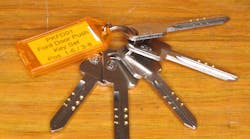When it comes to automobiles, each model and trim level seems to evolve every few years. Physical and digital security technologies constantly evolve, too, and it’s in the best interest of auto manufacturers to remain on the cutting edge of security measures for the benefit of their customers (and to protect the automakers’ reputation). Quite often, an update to a vehicle’s appearance also leads to a change in its physical or digital security measures, which then requires a new key or a new remote. Because of the overwhelming variety of vehicles on the road, automotive locksmiths often are forced to maintain obscene levels of inventory to accommodate what they’re likely to encounter on service calls.
Keys to Inventory
How do you determine which keys and remotes you should stock? As daunting as the task might seem, there’s a proven method that most automotive locksmiths employ: Stock primarily for the vehicle makes and models that you’re most likely to encounter in your service area. If you go weeks without seeing a Subaru, for example, it would be counterintuitive to stock a deep Subaru inventory.
Remotes take up far more space than keys, so stock remotes that have the broadest coverage first — some remotes can work for more than a dozen models — then bulk up based on the vehicles that are most common in your region. Also, build up your inventory of standard transponder keys, because they consume far less space than do remotes, and they can get all vehicles that have keyed ignitions back on the road. In the event you encounter a vehicle that you aren’t stocked to program, your recourse will be to rely on your distributor to overnight the parts or visit your local dealership and pay through the nose for an OEM solution from the auto manufacturer. At least you don’t have to worry about your competition stocking those parts, because, odds are, they did the same homework and will experience similar inventory deficits.
Sounds simple enough, right? What about push-to-start vehicles? You can’t simply program a transponder key for those. You don’t have a choice but to stock smart keys unless you want to risk losing jobs to your competition. Smart keys are as bulky as remotes, often worse, and are FAR MORE EXPENSIVE, but you have to remobilize push-to-start vehicles, so you definitely will want to maintain some inventory of smart keys.
Technological advancements are a beautiful thing, but it can be astounding how quickly smart devices become obsolete. This becomes problematic for automotive locksmiths. Every year, we must learn all of the new vehicle immobilizer systems and their respective keys and remotes, then determine whether we have the correct hardware to cut and program a key. The worst offender — and I say this with a fair balance of respect and contempt — is Nissan, which feels the need to enhance its digital security measures across all models with an alarming frequency. This means a new key and remote is required every time. Nissan doubles down on the madness by redeploying the same physical design that its smart keys have maintained for more than a decade, so don’t lose your key packaging. Nissan is an extreme example, but we’re slowly beginning to see levels of end-user data encryption from the likes of Chrysler, so we can expect other auto manufacturers to follow suit.
All of this might sound a bit overwhelming, but there is good news for those who are willing to learn, adapt and overcome.
Working Remotely
Welcome to the world of transponder-key, remote and smart-key generation. The concept is simple: Every transponder key, remote and smart key ever made has a data signature that makes it different from all others. Radio-frequency (RF) devices are regulated in the United States by the Federal Communications Commission (FCC) and up north by Industry Canada (IC). All automotive remotes and smart keys must undergo a testing process and, after approval, receive unique FCC and IC identification numbers. Most remotes and smart keys have their FCC ID printed on the back of the case or on the actual remote circuit board. Barring a couple of exceptions, such as Nissan and Chrysler, this FCC ID is the most reliable way to identify precisely which remote or smart key your customer requires.
Aside from this unique fingerprint, remotes and smart keys send their signal via RF transmission within a range of 275 to 902 megahertz, which is partly why other vehicles don’t open when you press your remote’s unlock button.
What if someone could harvest the data signatures from each of these items, then create a blank transponder chip, remote or smart key that corresponds with any of those signatures? Well, that’s exactly what we’re witnessing with transponder technology. There are countless benefits to this practice, prime among those being the ability to reduce the physical inventory in your already-cluttered van. You also gain the ability to produce keys and remotes on demand for vehicles for which you don’t stock inventory.
You don’t have to make customers wait for you to order parts. Best of all, these universal keys and remotes cost many times less than most of their proprietary aftermarket counterparts and often look and feel better than the OEM originals.
Chips in Play
Let’s begin by exploring some advancements in aftermarket transponder-chip technology. A substantial variety of automotive transponder chips exist on the market, the differences among them being their physical architecture and the unique data fingerprints that have been written to them. If you were to read the data on any chip, you’d see pages of proprietary information relevant to the system for which that chip was designed, followed by pages of data that are unique to that specific chip. The unique datasets exist so the chances of two chips containing the same information are diminished greatly.
As aftermarket technology progressed, companies figured out ways to replicate a lot of the immobilizer-specific data and write it onto blank chips. These chips then can be loaded with the information necessary to program to the immobilizer system specific to your customer’s year, make and model. This practice is known as “transponder chip generation.”
We also were able to figure out ways to copy entire datasets from keys that have been programmed to vehicles and copy them onto blank or cloning chips. Simply copy the entirety of a used transponder chip’s data and insert it in the proper key housing, and your vehicle will be unable to tell the difference between the copy and the original. This is known as “transponder chip cloning.” Writing data to a blank chip or a cloning key is an essential part of making keys for vehicles that don’t have on-board diagnostics (OBD) programming capabilities.
There are limitations to chip generation and cloning, however. Not every transponder chip can be generated from a blank, nor can they all be cloned to a precise copy. Recently, XHorse released the VVDI Super Chip, which can synthesize and replace dozens of transponder and cloning chip types and has been seen as one of the most significant recent advancements in the automotive locksmith industry. The result: Again, you have fewer chips to stock with the added benefit of creating chips for vehicles on the fly. VVDI Super Chips also are significantly cheaper than are most transponder chips. Loose transponder chips can be inserted into key shells, which look like regular transponder keys, but with a slot in the key head where a chip can be inserted. After it’s assembled, these keys can be cut and programmed to a vehicle as usual.
Another recent advancement in transponder-key production is the Multi-Function Kit (MFK) from Global Tecspro. A single kit provides the flexibility to create hundreds of mechanical keys in 24 of the most common keyways. Combine them with MFK key heads and transponder chips, and now you have the ability to create hundreds of different transponder keys, which certainly will clear up valuable space in your van. This method is the least expensive way to obtain a functional transponder key, which certainly is worth noting.
Next up is remote and smart-key generation. Most everything that was mentioned about the data signatures of transponder keys is relevant here, so it doesn’t bear repeating. Upon programming, vehicles look for proprietary, encrypted data from remotes and smart keys in a similar fashion as they do transponder keys. Using a remote generator, you can take a blank remote or smart key and encode it with the data your customer’s vehicle expects to see. Blank universal remotes and smart keys come in a large variety of styles. Although some are meant to imitate the design of their OEM counterparts, others are intended to be universal replacements, so you can keep inventory that can be used on almost any vehicle.
There is a bit of a learning curve involved in understanding the differences between the various universal-remote and smart-key types and how to prepare them for programming, but it isn’t rocket science. Information on how to perform these tasks is readily available online, or you could take a class.
Eventually, with the proper understanding of how everything works, you'll find yourself making flip keys for vehicles that never provided that option from the factory. You can expect to see a reduction in inventory on those previously mentioned bulky remotes and smart keys that typically consume a large portion of your workspace. You also will gain the ability to make keys and remotes for vehicles that you otherwise wouldn’t have had parts for. Most of the universal remotes and smart keys on the market cost anywhere between $10 and $25 each and have the capability of replacing OEM smart keys that can cost upward of $200 apiece. This gives you some flexibility in pricing with your customers while presenting them with options that are far less likely to cause a heart attack. It also gives you some room to include some margins for yourself, whereas selling OEM product yields diminished returns because of the exorbitant costs involved.
The VVDI Key Tool (Mini and MAX) from XHorse and the KD-X2 from KEYDIY are examples of remote generators that provide you with the ability to identify, generate, edit and clone transponder chips, remotes and smart keys. The Key Tool and KD-X2 each maintain proprietary ecosystems of transponder chips, universal remotes and smart keys that can be used to synthesize exactly what your customers require. Aside from chip and remote generation, they include a host of complimentary features locksmiths must have to do their jobs. Among them are transponder coil detection, which is useful for testing the signal from an ignition coil to determine whether a vehicle is immobilizer-equipped, and remote signal testing for troubleshooting your remotes for proper functionality.
XHorse will get into the OBD key-programming game soon with its upcoming Mini OBD Tool. The full capabilities of the Mini OBD Tool still are shrouded a bit in mystery, because its release date has been pushed back repeatedly. However, what we’ve seen on our prototype looks extremely promising. Upon release, the diagnostic software suite should include the ability to read and clear check-engine codes, modify antilock braking systems, adjust tire-pressure monitoring system settings, performance-tune the engine-control module and so much more.
Dedicated OBD programmers always will be a mainstay, but nothing else will come close to giving you the full suite of complementary features that automotive locksmiths require to do their jobs as a remote generator will. If you have yet to explore the world of remote and transponder-chip generation, this is absolutely the perfect time to get on board.
Mo Ali is vice president of product development for American Key Supply and has more than 20 years of automotive experience as an electrician and a locksmith.






